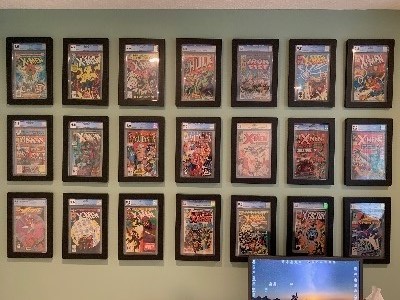Getting to Know Your CGC Case
In this article I will address some of the popular questions and misconceptions regarding the CGC slab, or case.. holder? ...Coffin?
Well however you refer to them keep reading to get the answers to some of the questions you may have regarding the only tangible product we get from CGC?
The CGC case has went through a few design changes over the years, the most recent being in early 2016 where arguably the most significant improvements were made over its predecessor.
So for the sake of this article I will primarily refer to spec's and information based on the newest generation of slabs.
But first...
How Do I know if I have the New Style CGC Slab?
The New Style case has ridge in the plastic that bumps out over the label section of the front of the case and an indentation in the plastic on the backside of the label, whereas the old style is flat on both front and back.
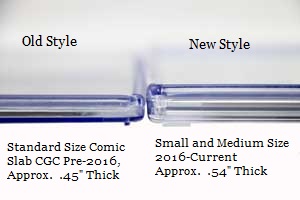
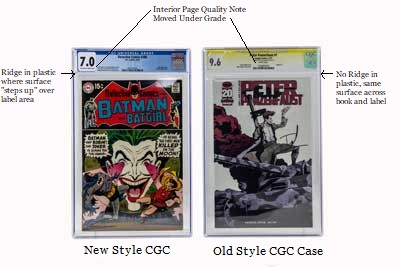
The new style cases are about .125" thicker overall giving them a much stronger and more rigid feel over the pre-2016 version. A few other smaller, but still very important changes are :
-The inner well material went from Barex to PETG
-The "Page Quality" notation went from the middle of the Label to the white box under the number grade of the book
-The legal info, or fine print on the back side of the label was removed and replaced with information about the encapsulated book
-The sticker on the top edge of the slab denoting the book and grade was moved to the label inside the plastic, leaving no opportunity to be removed or fall off.
-The CGC Hologram sticker at the top right corner was given some added detail making it much more difficult to be replicated.
What are CGC Cases Made of?
The CGC case has two main parts, the "inner well" and the "outer well". The inner well and most important part as it has direct contact with the comic, is made of PETG (Polyethylene terephthalate glycol). The outer well is made of a tough, impact and stain resistant plastic called SAN (Styrene-Acrylonitrile).
An explanation of PETG and SAN (in layman's terms) can be summed up this way, PETG is a widely used material that is great for preservation and long term storage. SAN is an impact and stain resistant plastic with great clarity.
***Reader Tip***If you want to get into the science behind the materials keep reading, otherwise just skip to the next heading that says "Are CGC Cases Water Proof?"
Mylar, a word most of us in the comic industry are familiar with, is a PET (polyethylene terephthalate)...a polyester, formally called BoPET, the "Bo" is simply short for "Biaxially Oriented" which refers to how it is stretched into sheets during production.
So what does that have to do with PETG? Well the addition of the "G" means Glycol was added which enhances the clarity and longevity of the pliability of the chemical makeup of PET over time.
PETG is an inert plastic, in plastic speak "inert" basically means "archival" another word many of us in comic books are aware of. In its "raw form" it is ideal for long term storage and preservation for our priceless collectibles. I say in its "raw form" because other materials could be introduced during manufacturing of PETG to accomplish certain specific needs required by the end product or intended use. Why does this matter? Well as soon as any other materials are introduced it may still be referred to as PETG but that end product may no longer be suitable for long term storage, possibly having adverse affects on what it comes in contact with, ie...our comic books.
Now I am quite certain our friends at CGC have our best interests in mind and would be sure their manufacturers keep any non archival materials out of the process.
The outer well really is not that important when it comes to archival quality as it is not going to touch the book, however other qualities are important here.
Clarity, scratch resistance, durability, these are some characteristics that will help keep our investment safe and looking beautiful for years to come. Well CGC did a great job here as well, SAN is what they call a "Copolymer" meaning it combines two or more materials (in this case styrene and acrylonitrile) to produce (in this case) a rigid, clear material with high impact resistance and good heat and chemical resistance. Something to keep in mind, in this situation clarity is key because we all want our books to look bright and vibrant in these cases. As soon as you start adding materials that are more scratch resistant and durable, that clarity lessens more and more.
So in the end CGC did a great job in choosing some great quality material that embodies the best of all of the necessary characteristics we want.
Is everyone still with me? Hopefully I didn't lose you through that science lesson.
What is important to us, as comic collectors is that PETG is about as safe as a material that we can ask for to have our ever degrading paper collectibles packed inside of.
Are CGC Cases Waterproof?
No, CGC cases are not waterproof, water resistant is a much more correct term. For the sake of the comic book inside neither the inner or outer well are completely sealed.
It may take some time to seep in but eventually if left soaking in a tub of water, the water will reach the comic book.
In an interview with Comictom, Matt Nelson head grader at CGC stated that they have tested leaving a slab in a tub of water and eventually the water made its sway in and ruined the comic book inside. A joke was made that if a slab were accidentally dunked into water and pulled back out (like an Oreo cookie), it would probably be ok. He also went on to say that it should be common sense, don't drop your book, don't leave it in direct light, don't leave it in a hot car and it will be fine. Perfect response! Use common sense! Read the article and watch the full video " Debunking x3 CGC Myths" on ComicTom's website here.
Ok, So why are the comic books not completely sealed inside? An article I found on the Library of Congress website gave a very good reason as to why paper products should not be sealed up air tight. "In the presence of moisture, acids from the environment (e.g., air pollution, poor-quality enclosures), or from within the paper (e.g., from the raw materials, manufacturing process, deterioration products), repeatedly cut the glucose chains into shorter lengths. This acid hydrolysis reaction produces more acids, feeding further, continued degradation."
-You can read the full article on the Library of Congress website, here
CGC adds a sheet of microchamber paper to the front and back inside covers of every comic book they encapsulate to help absorb those acids that are constantly being released from our comics, so then why can't they be sealed tight to keep the outside air pollutants and moisture from seeping in?
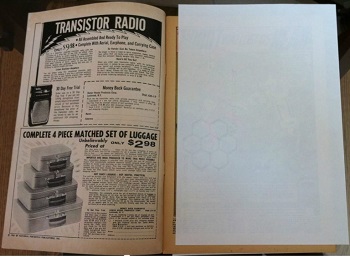
Photo Courtesy of https://www.brooklyncomicshop.com/guide-taking-care-comics/
Well, in a communication I had with a representative from the company that supplies the microchamber paper to CGC, her response to the question of completely sealing any paper product in a sleeve (even with microchamber paper), was just awesome,
"in the not-so-technical term as causing the item (whatever it may be) to “stew in its own juices” as anything will continue to age, certainly not as quickly, but with aging comes off-gassing various by-products of deterioration. If the package is completely sealed, there is no escape and a [stew] of chemicals form."
Further to that, the chemicals may not all remain just as they are when released. That is to say, if by-product of deterioration A and B are both released, there is a concern that they will combine and form chemical AB, which may cause even further issues." She went on to say that "breathing, is the goal."
Essentially all paper materials have a moisture content and sealed moisture along with the acids from the the paper and ink may in some cases accelerate the degradation of the paper.
Interleaving paper, or "microchamber" paper that CGC adds to the inside of the books is designed to absorb some of the acids released by the paper in the comics, however if sealed air tight it could result in deterioration as well.
Do CGC Slabs Have UV Protection?
No, CGC Cases have no built in protection form damaging UV rays that could fade or deteriorate the comic, magazine or art inside. The inner and outer well of the case are made from raw materials such as PETG and SAN and have no added UV inhibitors.
Personally I am happy that their cases are not UV safe, if they were many of the UV Blocking Products we offer for Graded Comic Books would be unnecessary!
But really, why does CGC not add UV inhibitors to the outer well of their cases? I mean that would be just another level of added protection for the comic inside, correct?
Well, here is a couple things to think about, although slight, adding a UV inhibitor to the SAN Copolymer mixture will affect the clarity of the plastic, taking a small step backwards from one of their goals. Cost is another factor to consider, for reference I can give you an example from personal experience, a sheet of standard acrylic is less than one-half the cost of a sheet of 99% UV Safe acrylic of similar size and thickness.
The best answer I could get from a CGC rep when I asked about why they do not have UV protected cases was "We looked into UV for outer cases a few years ago and there were some issues (not cost) as to why it wouldn’t work, but I’m not exactly sure what those reasons were."
If you are looking for some UV protection components for your CGC Graded Comics and Magazines, check out this website.
How Many Different Size CGC Slabs Are There?
Referring to the most current revisions, or Generation of cases only, CGC uses three sizes of cases for encapsulating comic books and two different sizes for magazines or large format comics.
It is also worth noting that they have several sizes of slabs to hold single page original art, 11"x17" and 9"x12" for sure, but I am quite certain there are other sizes as well.
Even more, CGC's parent company, Certified Collectibles Group (CCG) has several other grading companies that use MANY other types of cases of all shapes and sizes for encapsulation, so really they could likely grade just about anything...if you're willing to pay for it!
But again for interest of this article we will only focus on the five main sizes primarily used in the comic book industry. According to CGC they are broken into two groups, "comic book size" and "magazine size". These groups are designated by the overall width and height of the case, then broken down from there by the thickness of the case and subsequent thickness of book each will hold.

Comic Book Size Cases (8.13"wide by 12.9" tall):
1) Small(.52-.54" thick)- Used for thin books with few pages, generally up to about 26-28 pages. Preview books or ashcan books are good examples.
-Although this case and the medium case are the same thickness the difference actually lies in the back half of the slab. On the small size the back half of the outer well of the slab is actually indented, or sunken in. What this does is actually create a thinner dimension on the inside of the case where the comic book mounts, thus it it used for thinner books. The medium size case does not have this sunken in back, it is much more flush, creating more space inside the case for a thicker book.
2) Medium(.52-.54" thick)- Holds most comics up to about 48-64 pages. Depending on page weight and cover stock.
3) Large-(.76-.78" Thick) Used for square bound comics, annuals, many Golden Age, Giant Size and some trade paperback books.
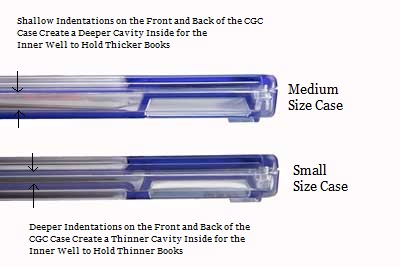
Magazine Size Cases (9.625" wide by 13.8" tall):
1) Small(.46-.48" thick)- Used for most Golden Age Dell and Gold Key, Treasury Edition, Sports Illustrated, Playboy, TMNT (1984)
2) Large(1.25-1.3" thick)- Large Square bound books, Hard Covers, oversized issue Sports Illustrated, large format comics with
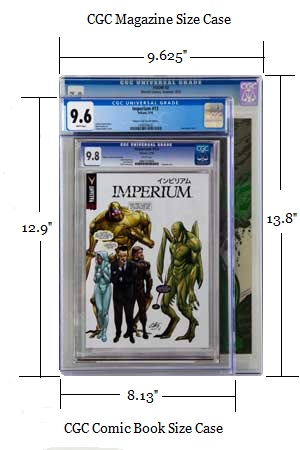
***Something to keep in mind is that just because your book may fall into a certain category or size constraint for a particular slab size it does not guarantee that will be the slab you get with your book in it. There have been numerous forum and facebook posts about someone submitting a standard sized modern book with the typical 36-40 pages and it will come back in a thick Golden Age slab. I have even seen a couple forum posts where already graded books were sent in for re-slabbing or re-grading in a standard sized slab, only to have it come back in a thick slab, or vice-versa.
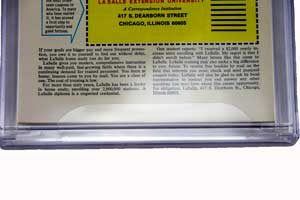
Why is There a Plastic Flap Inside My CGC Case?
The plastic flap sometimes used either along the spine or bottom edge of the comic book is simply put in place when needed to keep the book from shifting or moving inside the slab.
Will CGC Cases Break?
yes, they are made of plastic materials more focused on protection, preservation and clarity over durability. Having a more durable case would mean sacrificing those other qualities.
Can a CGC Case be Opened?
Yes, but not without damaging the case and therefor rendering the grade and any certified signatures or markings on the book (if applicable) invalid. Unless done by or in the presence of and authorized CGC representative.
Here are a few scenarios in which you may want to open your slab and remove your comic but still want to preserve certain characteristics about the book.
1)You want to get your comic pressed and cleaned. -A regrade is your goal in this situation so removing the book from it's current slab on your own is acceptable.
2)You want to get your comic reholdered into a new slab but you want to keep the grade on your current slab. -You MUST send the entire sealed slab in to CGC for reholdering.
***It is worth noting that although unlikely it is possible to have the comic come back a different grade after reholdering. On a side note to this scenario, if you are reholdering due to a damaged case, if the case is broken or separated to the point that the comic book can be removed, the comic will be regraded.
3)You want to get an artist or writers signature on your book (that currently does not have any authorized signatures, Blue Label) -You may remove the book on your own
because whenever a signature, remarque or anything is added to the comic it will automatically get re-graded. However remember that you MUST get the signature, remarque, etc in the presence of an authorized CGC representative.
4) You want to get additional signatures, etc. on a book that already has signature(s) -The book will get regraded no matter what however do not open the case unless in the presence of an Authorized CGC representative or the existing signature(s) on the book will no longer be certified.
So that's it! I hope this information helps to answer some of the questions you may have had regarding your CGC cases. If you are looking for answers to questions I missed in this article I would love to hear them and I will do my best to track down the answers for you! You can email your questions or comments to tony@gradecomstore.com


